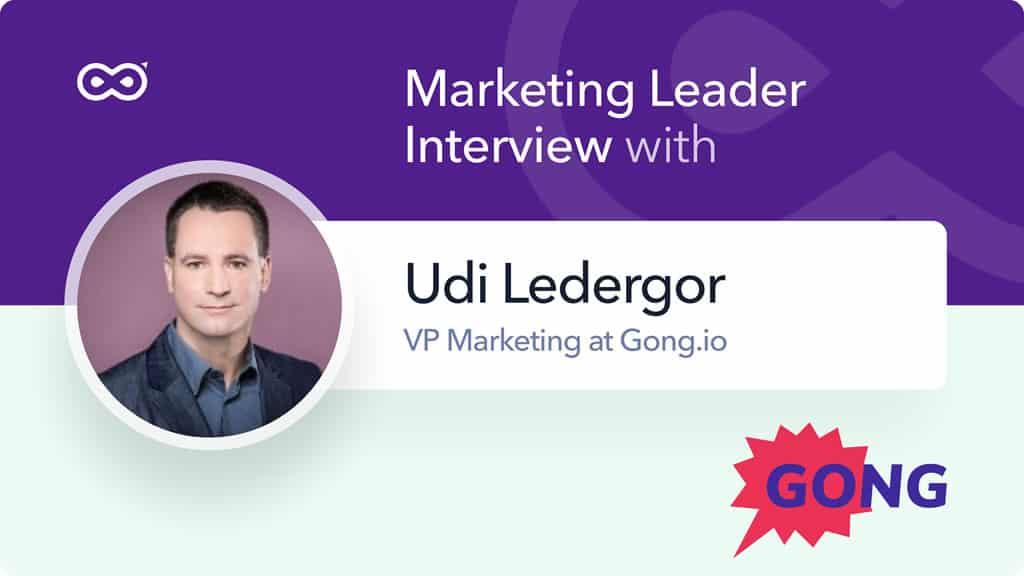As part of the journey of providing you with the latest and greatest insights about marketing planning, we continue to interview marketing leaders who inspire us and the entire industry. We’re more than happy to let you pick into one of the brightest minds in B2B marketing – Udi Ledergor.
Udi is the VP of Marketing at Gong.io, a conversation intelligence platform that automatically records, transcribes, and analyzes B2B sales teams’ calls. But the amazing work that Udi does at Gong isn’t his first; he’s actually a 5-time VP of Marketing with 20 years of industry experience heading world-class marketing teams for public and private companies across a variety of industries. Udi is also the author of the #1 Amazon Best Seller – The 50 Secrets of Trade Show Success.
What is your biggest challenge in terms of marketing planning?
As a start-up, we’re in a constant state of learning, trying, and testing. It’s challenging to commit to an annual budget early in the year before testing our plans to figure out what will work and what won’t.
We need to leave a lot of room for flexibility between budget line items to allow us to quickly shift budgets from activities that aren’t producing as we’d hoped to more promising ones.
As a start-up, we’re in a constant state of learning, trying, and testing.
How often do you adjust your marketing plan after you create it?
Constantly. We decide on what we want to test, how long we need to run an activity to get enough results data to assess its results and stick to it until we get those results. If we like them, we look for ways of scaling that activity. If we don’t like the results, we quickly divert budget and other resources to other activities.
We’re constantly bombarded with new marketing investments we hadn’t considered. It’s important to keep an open mind and budget for running small pilots and tests to see what could work for us.
Which marketing channel do you think is the most underrated?
Creating unique, thought-leadership content that truly adds value to the community. Most of the marketing content I receive today looks like spam, at best. It’s truly refreshing to receive up-to-date, valuable content that actually improves my daily work life.
We try and create that sort of value at Gong.io every single day by running sophisticated analyses on our accumulated data, to produce exclusive insights that help salespeople have better conversations. They can’t get this content anywhere else and judging by the thousands of social shares, retweets, and conversations started around our content – we seem to have hit a real pain point.
It’s important to keep an open mind and budget for running small pilots and tests to see what could work for us.
What are your top 3 tips for start-ups to get started with their marketing planning?
1. Start with your prospects – what challenges do they face every day? What problems are they trying to solve? How can you help them solve those problems with your marketing, not necessarily with your product? For example, if they need information you can provide in eBooks, templates, or cheat sheets, you could quickly become a valuable asset to your prospects by creating and delivering those on a consistent basis.
2. Find out where your prospects are going to network and gather information – both online and offline. Now, make sure you’re there when they show up: distribute your content, advertising, and physical presence where your prospects are most likely to look for it.
3. Fail quickly. Start testing each marketing channel you’re considering with the minimal pilot you can get away with, while still collecting enough meaningful data to draw conclusions. If you see it’s a good fit – great! Now, scale. If it’s not a good fit – pack up and go elsewhere with your time and money.
What is the most common marketing mistake you see?
Making gut-feeling decisions instead of backing everything up with data. In today’s marketing world, more than 90% of what we do can and should be measured. If you don’t know how people are finding your website, and which referral source has the highest likelihood of converting to customers, you’re doing it wrong.
In today’s marketing world, more than 90% of what we do can and should be measured.



